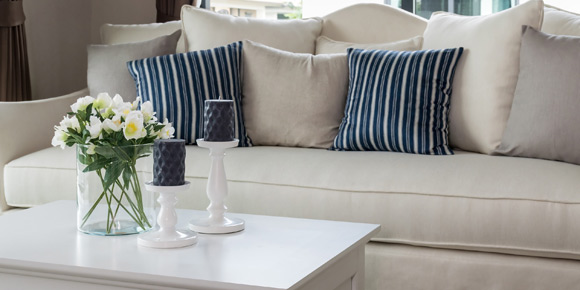In most homes, the couch is the hardest working piece of furniture: it’s full-time theatre seating, a part-time dinner table and occasionally even a bed! Learn how to choose the right fabric and the best construction materials to find the perfect couch.
How will you use the couch?
With so much resting on your couch (you included), it’s worth the extra time it takes to pick the perfect one. Before you think about how it looks, consider its function. Do you often have friends over for get-togethers, or are you more inclined to enjoy weekly movie nights for two? Do you have relatives who like to visit and need a place to sleep?
Wrap-around couches provide extra seating for the frequent entertainer, while sofas with built-in recliners are great for movie enthusiasts. Sleeper-sofas will make guests feel more comfortable.
Choosing the right fabric
When picking fabrics, think about who will be using the couch. Do you have children or pets?
Cotton and linen are soft to the touch and popular choices, but synthetic fibres are better options for homes with furry friends or kids. Leather can be easier to clean than fabric, but is harder to repair if damaged. Faux leather is a more affordable, practical choice.
Picking placement
Where you position your couch will determine how people interact in the room. A couch facing the television will end up being the seat of choice on movie night, while a couch facing more seating will encourage conversation. In larger, open floor plans, a couch can define a smaller space within the room, especially if combined with an area rug.
Choosing construction materials
Under the upholstery, there are three structural elements to consider: the frame, the springs and the padding.
• Frames:
Wood
The most common material.
Prices increase with stronger hardwoods.
• Steel:
The most durable material.
• Fibreboard or plastic:
Less expensive.
Least durable.
• Springs:
Traditional
Most durable.
Take up the most space.
• Sinuous:
Long, wavy springs running front to back.
Good for low-profile couches.
• Fabric webbing:
Least durable and can cause cushions to sag over time.
Provides hammock-like support.
Least expensive option.
• Padding/cushions:
Polyurethane foam
Most common option.
Sometimes wrapped in cotton or polyester fibre for comfort.
• Down:
More expensive.
Requires more maintenance.
Tip: Sitting on the couch is the only way to make sure it’s comfortable. If this is the primary couch for your home, don’t be too worried about cushions that feel a little stiff — you’ll break them in before long. But if it’s going to be an occasionally used piece of furniture, you might want to choose something a little softer.
Accessorizing to make it your own
Throw pillows are an inexpensive and easy way to change the look of both the couch and the room. Add a splash of geometric design with a large 20-inch pillow, or mix and match patterns until it feels right to you. If you need inspiration, check design magazines or Pinterest to see what’s on trend.
And then, take a nap. You’ve got the perfect place to enjoy one!
— SmartMoves, Canada Post.



